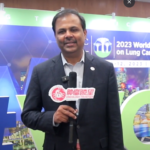The 2023 World Conference on Lung Cancer (WCLC), organized by the International Association for the Study of Lung Cancer (IASLC), took place in Singapore from September 9th to 12th. Dr. Stephen V. Liu from Georgetown University presented an important study (Abstract No: OA01.04) on the long-term follow-up results of first-line immunotherapy combined with chemotherapy in ES-SCLC patients. Oncology Frontier invited Dr. Liu to highlight his presentation at the conference.
OA01.04 Five-Year Survival in Patients with ES-SCLC Treated with Atezolizumab in IMpower133: IMbrella A Extension Study Results
Introduction: In the Phase III IMpower133 trial (NCT02763579), first-line treatment with atezolizumab + carboplatin/etoposide (A+CE) improved OS and PFS vs placebo + carboplatin/etoposide (P+CE) in patients with ES-SCLC. At the time of IMpower133 study closure, patients treated with A+CE were eligible to enrol in the Phase IV, single-arm IMbrella A extension and long-term observational study (NCT03148418). Given the interest in long-term OS data for immunotherapy in ES-SCLC, we report patient outcomes from IMbrella A as an extension of the IMpower133 results.
Methods: Patients enrolled in IMpower133 were eligible for roll-over to the open-label, non-randomised, multicentre IMbrella A extension study if they continued to receive atezolizumab at the time of IMpower133 closure and did not have local access to the study treatment or if they discontinued atezolizumab in IMpower133 and were in survival follow-up. Patients in the P+CE arm were not eligible for enrolment. Survival, treatment status and safety were assessed in IMbrella A.
Results: Median follow-up was 59.4 months in the A+CE arm (IMpower133 and IMbrella A; clinical cutoff date [CCOD]: 16 Mar 2023) vs 26.4 months in the P+CE arm (IMpower133 only; CCOD: 24 Sep 2022). A total of 18 patients from the A+CE arm of IMpower133 were enrolled in IMbrella A. The 5-year OS rate in the A+CE arm was 12% (IMpower133 and IMbrella A) (Table). Of the 11 patients still alive at the data cutoff date, the median age at baseline was 59 years, 4 patients had an ECOG PS of 1, 2 patients had baseline brain metastases and none had baseline liver metastases. MD Anderson Cancer Center SCLC subtype information, based on expression of neuroendocrine (SCLC-A and SCLC-N), non-neuroendocrine (SCLC-P) and immune-infiltrated (SCLC-I) transcriptional signatures, was available for 7 of 11 patients who were alive at 5 years (SCLC-A, n=1; SCLC-I, n=2; SCLC-N, n=4).

Conclusions: This long-term follow-up analysis of IMpower133 patients enrolled in the IMbrella A extension study provides the first report of 5-year survival outcomes for patients who received first-line cancer immunotherapy for ES-SCLC and demonstrates that durable survival benefit up to 5 years is possible with A+CE.
Oncology Frontier :What is the significance of the IMpower133 study’s Imbrella A extension research results in SCLC?
Dr. Liu: The IMpower133 study is a phase III study on first-line treatment for extensive-stage small cell lung cancer (ES-SCLC). The results from 2018 indicated that adding immunotherapy to chemotherapy improves survival rates in SCLC patients. And the Imbrella A extension study is a continuation of the IMpower133 study . The recent results from the Imbrella A extension study found that the 5-year overall survival rate for patients treated with atezolizumab + carboplatin + etoposide is 12%. Although 12% is not as high as hoped, it’s significantly better than the previous 2%, with survival rates appearing to stabilize after five years.
Oncology Frontier : Is there a correlation between SCLC subtypes and treatment outcomes for SCLC patients in the Imbrella A extension study at the MD Anderson Cancer Center?
Dr. Liu: Subtypes of small cell lung cancer define distinct tumor biological behaviors. These subtypes are categorized by the expression of certain transcription factors. However, although they indeed define various biological subtypes, we’re unsure how to use them in practical terms. As we observed in the Imbrella A extension, they seemed irrelevant in identifying long-term survivors. Although benefits seemed to be linked to inflammatory gene characteristics, they didn’t predict long-term survival. The subtyping method used by MD Anderson does distinguish between different subgroups, but we’re uncertain how to use this clinically. As of now, no one should be denied of immunotherapy based on these biomarkers. The current approach is to provide immunotherapy to all ES-SCLC patients.
Oncology Frontier :What treatment options will SCLC patients receive after disease progression following first-line treatment in the IMpower133 study’s Imbrella A extension? How can clinicians increase the likelihood of SCLC patients receiving second-line treatment?
Dr. Liu: Our goals for everyone to experience long-term survival. However, for those who don’t have a durable response to combined chemo-immunotherapy, the FDA has approved second-line drugs like lurbinectedin or topotecan. And many other promising drugs are emerging, with bispecific drugs and bispecific T-cell engagers targeting DLL3 showing potential. Enhancing opportunities for SCLC patients to receive second-line treatments requires high-frequency monitoring, given the rapid progression of the disease.
Oncology Frontier :Could you share more about your interests in the SCLC treatment field?
Dr. Liu: For small cell lung cancer, immunotherapy holds promise because of its potential for long-term survival. Some newer drugs, like antibody-drug conjugates, have shown early encouraging results. Combining them with immunotherapy could result in synergistic effects. Traditional treatments, like radiation, can be combined with chemo-immunotherapy for extensive-stage SCLC patients.Please stay tuned for forthcoming results.



